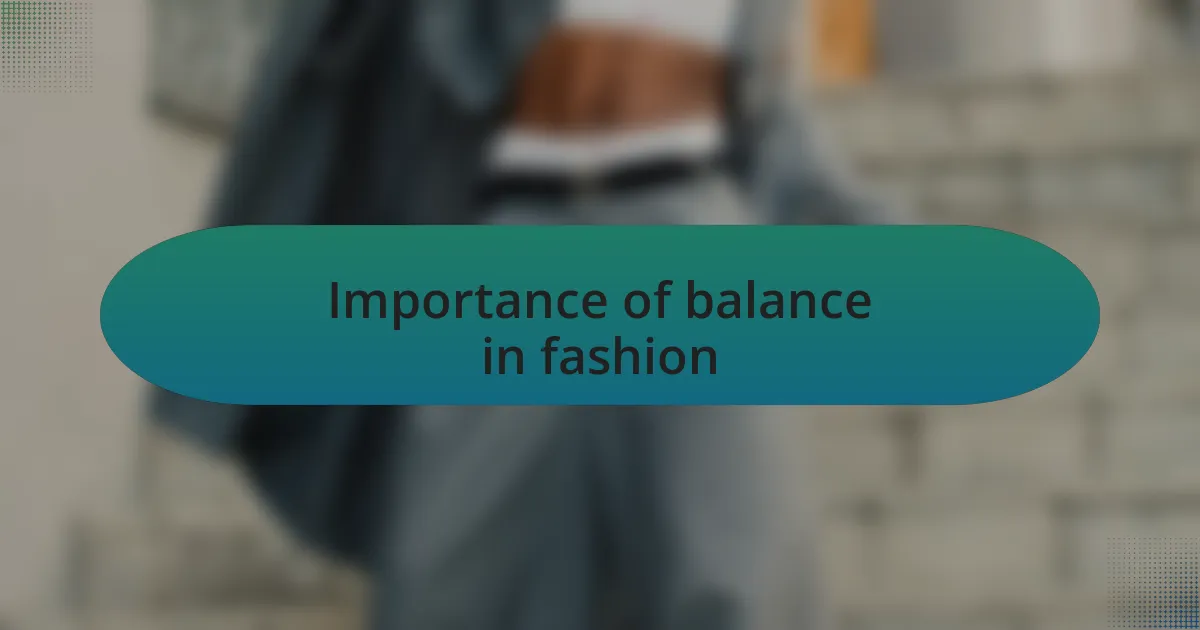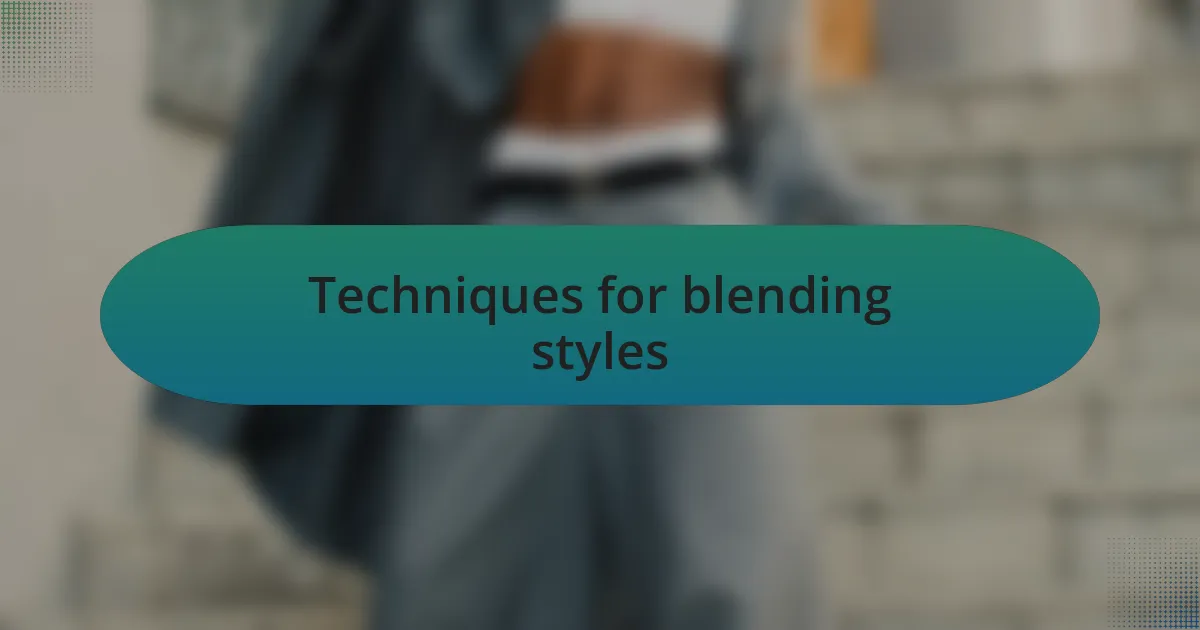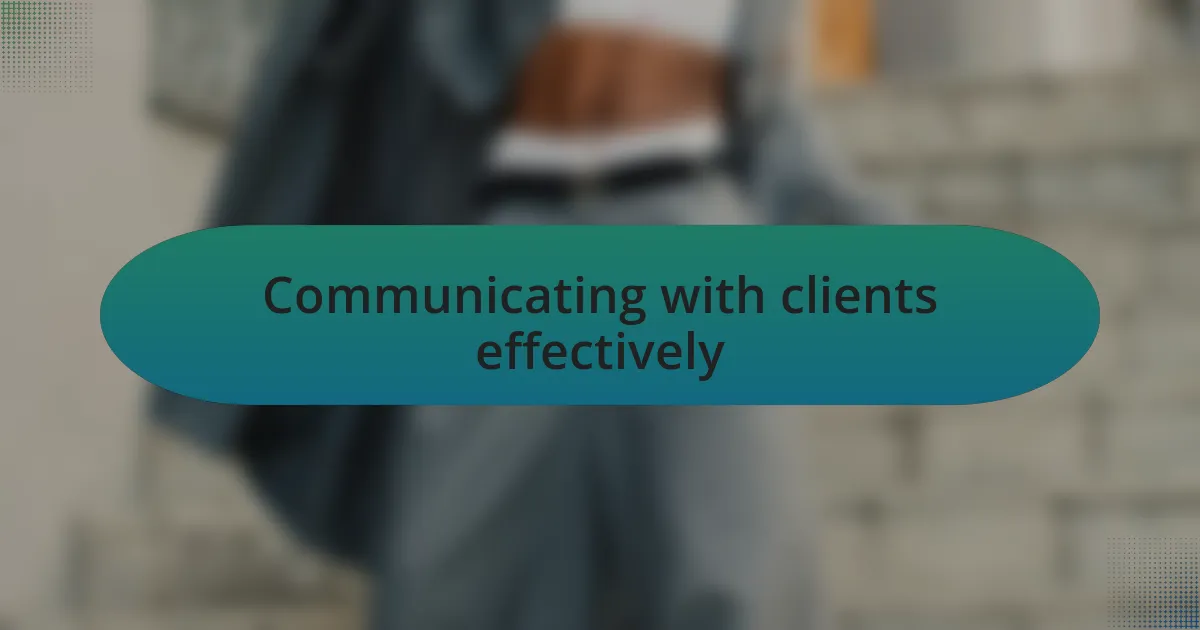Key takeaways:
- Personal style is an expression of identity, shaped by confidence and evolving through experiences.
- Understanding and adapting to client needs through empathy and effective communication is essential in the design process.
- Maintaining a balance between personal artistic vision and client preferences fosters collaboration and innovation.
- Authenticity in design is achieved by integrating individual style with client desires while staying true to one’s artistic philosophy.

Understanding personal style
Personal style is more than just clothing; it’s an expression of who we are at our core. I remember the first time I discovered my style—a vintage leather jacket paired with a simple white tee. That moment taught me that every item we wear tells a story about our personality, experiences, and even our aspirations.
Understanding your personal style often involves reflection on what makes you feel confident and authentic. I frequently ask myself, “What outfits make me feel like the best version of myself?” This question has guided me through countless wardrobe choices, helping me curate pieces that resonate with my identity while also evolving over time.
It can be a journey to figure out your unique style, filled with trial and error. I often think about the fashion pieces I once loved but have since moved away from. This evolution is natural and exciting; embracing change allows us to grow and redefine ourselves as we navigate different stages of life.

Defining client needs
Understanding client needs is a pivotal step in the design process that shapes my approach to fashion. I often find it enlightening to sit down with a client, listening as they describe their vision, preferences, and lifestyle. It’s a treasure trove of insights that helps me tailor designs that truly resonate with their desired image.
When I first started working with clients, I made the mistake of overlooking the importance of detailed discussions about their needs. A memorable experience involved a bride-to-be who envisioned a dress that reflected both elegance and comfort for her beach wedding. By carefully exploring her thoughts and feelings, we crafted a gown that not only embodied her style but also allowed her to move freely—something that was so crucial for her special day.
I believe that asking the right questions is key to uncovering client needs. During a fitting, I might ask, “What do you want your outfit to communicate about you?” This opens the door to deeper conversations, helping me align my design vision with their expectations. Each interaction teaches me that understanding client needs requires empathy and a genuine desire to bring their fashion dreams to life.

Importance of balance in fashion
Finding the right balance in fashion is essential for creating designs that not only please clients but also reflect personal style. I remember a particular collaboration where the client wanted something bold and avant-garde, but my inclination was toward subtlety. By blending our ideas, we created a garment that turned heads while still feeling authentic to both of us. Isn’t it incredible how the fusion of different perspectives can lead to something truly unique?
Moreover, maintaining this balance helps me stay true to my design identity while adapting to various client preferences. I recall working on a project for a corporate client who sought to project authority without compromising femininity. By incorporating structured silhouettes paired with softer fabrics, we managed to craft a collection that aligned perfectly with her vision and professional image. This experience reinforced my belief that fashion isn’t just about aesthetics; it’s about communicating who you are in a way that feels right.
On the flip side, I sometimes grapple with how much of my individuality to infuse into client projects. Striking this equilibrium often leads me to ask thought-provoking questions like, “How can I incorporate my style without overshadowing your preferences?” This dialogue not only clarifies expectations but also nurtures innovation, reminding me that fashion is ultimately about collaboration and mutual respect. It’s this ongoing journey of balancing influences that keeps my passion for design alive.

Techniques for blending styles
When I dive into blending styles, I often start by identifying key elements from both my aesthetic and my client’s vision. For instance, during a recent project geared towards a bohemian theme, I infused my love for geometric patterns into flowy, relaxed silhouettes. The result? A collection that felt both free-spirited and structured, bridging our styles in a way that surprised me and delighted the client.
I find that mood boards are invaluable tools for this process. On one occasion, I created a vibrant board that featured both my minimalist tendencies and my client’s passionate color palette. As we browsed through fabrics, textures, and images, the conversation flowed naturally. That collaborative space makes it easier to articulate what we each love about different styles. Have you ever noticed how visually piecing things together can ignite creativity and clarify shared goals?
Sometimes, it’s about allowing flexibility in execution. I recall designing a lookbook for a client who wanted pieces that could transition from day to night. I included multifunctional elements, like convertible dresses and interchangeable accessories, so her personal style could shine through in various settings. By adopting this adaptive approach, both of us could embrace our preferences while crafting something versatile and unique. It’s fascinating how a simple shift in thinking can lead to unexpected, beautiful outcomes in fashion.

Communicating with clients effectively
Understanding my client’s needs is just as crucial as expressing my own design style. I often kick off our conversations by asking open-ended questions that invite them to share their aspirations, inspirations, and concerns. For example, I once asked a client about her favorite childhood memory connected to clothes. The insightful tales she shared led to the creation of pieces that felt personal and nostalgic, taking the design beyond just aesthetics to evoke emotions.
Active listening is a game-changer in my communication strategy. During a fitting session, I noticed that my client hesitated about a particular hemline. Instead of brushing it off, I paused to explore her feelings. Her discomfort was rooted in wanting a look that embodied confidence. By taking time to address her concerns and adjust the design accordingly, I fostered a deeper connection, ensuring she felt heard and satisfied.
I also believe that visual aids can bridge any communication gaps. One memorable instance was when I used simple sketches to depict different design options. My client’s face lit up as we discussed each choice, and she began envisioning how the pieces would come together. Have you found that visuals can express ideas more clearly than words alone? This interaction not only clarified our direction but also energized our collaboration, making the entire process enjoyable and productive.

Adapting designs to client preferences
Adapting designs to client preferences often requires a delicate balance between my artistic instincts and their vision. I remember a time when a client adored vintage dresses but desired a modern twist, so I incorporated unexpected fabrics and sleek silhouettes that maintained the essence of her nostalgic inspirations. It’s moments like these that energize my creative process—how can I create something fresh while honoring a client’s unique taste?
Understanding the emotions tied to fashion choices can deeply influence my design adjustments. One client expressed anxiety about dressing for an upcoming event, fearing she wouldn’t feel confident. I decided to integrate subtle details, like a flattering neckline and playful draping, to not only enhance her figure but also uplift her spirit. This transformation wasn’t just about style; it was about making her feel empowered and beautiful. Have you ever crafted something special that made someone feel great about themselves?
Finding the sweet spot between personal style and client preferences is like a dance. I often compile a mood board filled with various textures, colors, and silhouettes to spark dialogue. During one session, my client hesitated over a bright color I proposed. Rather than push my choice, I offered alternative shades that still captured her personality but eased her reservations. This collaboration not only led to a design she loved but also strengthened our relationship, reinforcing the idea that adapting to client preferences is a mutual journey.

Maintaining authenticity in your work
Maintaining authenticity in my work is crucial for staying true to my artistic vision while catering to clients’ needs. I recall a client who wanted an extravagant red carpet gown, but deep down, I felt drawn to a more ethereal and understated design. After discussing my thoughts with her, we compromised, blending my love for simplicity with her desire for glamour. That experience reinforced my belief that authenticity does not mean dismissing client input; instead, it empowers me to find innovative ways to create something uniquely us.
There are times when I face pressure to conform to trends that don’t resonate with my design philosophy. I once worked on a collection where everyone seemed to favor bold, flashy elements, yet my heart yearned for timeless elegance. I remember standing in the fabric store, envisioning how a classic silhouette would tell a story beyond mere aesthetics. This moment taught me that my authenticity shines brightest when I trust my instincts, and it ultimately led to creating pieces that felt like an extension of my soul.
Finding authenticity is an ongoing journey rather than a destination. Have you ever felt torn between commercial success and staying true to yourself? I often remind myself that my designs reflect who I am and what I believe in. In those moments of doubt, I draw inspiration from my experiences and the stories my creations tell, ensuring that every stitch resonates with authenticity, establishing a deeper connection with my clients.